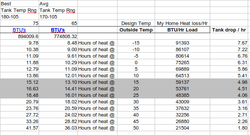I am trying to decide on boiler size for my system and I was wondering if anyone has any 'real world' data on average boiler output over a complete burn cycle
compared to 'rated' boiler output.
I have enough storage to oversize the boiler and would like to be able to bring my storage(650 to 700 kbtu's) up to temp in 5-8 hours.
Something around the size of an eko/biomass 40 seems about the size I would need... thoughts?
Or... should I go for a longer burn with a smaller boiler? I start the fire around 5:00 pm and last fill could be 11:00 pm, so 9-10 hours max if a load gives 3-4 hour burn.
Heat loss around 60,000 on design day(which is rare) Storage will give me 18 hours or more on all but a few of the coldest days.
Kris
compared to 'rated' boiler output.
I have enough storage to oversize the boiler and would like to be able to bring my storage(650 to 700 kbtu's) up to temp in 5-8 hours.
Something around the size of an eko/biomass 40 seems about the size I would need... thoughts?
Or... should I go for a longer burn with a smaller boiler? I start the fire around 5:00 pm and last fill could be 11:00 pm, so 9-10 hours max if a load gives 3-4 hour burn.
Heat loss around 60,000 on design day(which is rare) Storage will give me 18 hours or more on all but a few of the coldest days.
Kris



